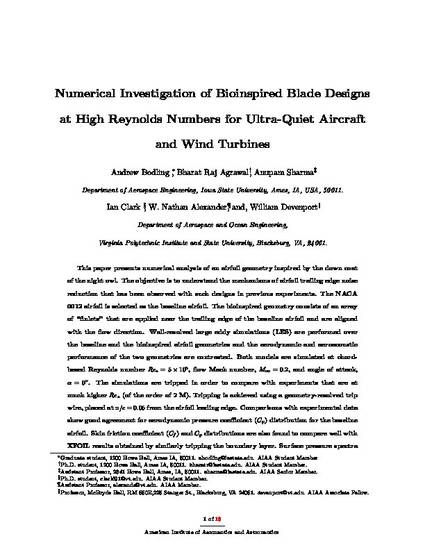
This paper presents numerical analysis of an airfoil geometry inspired by the down coat of the night owl. The objective is to understand the mechanisms of airfoil trailing edge noise reduction that has been observed with such designs in previous experiments. The NACA 0012 airfoil is selected as the baseline airfoil. The bioinspired geometry consists of an array of “finlets” that are applied near the trailing edge of the baseline airfoil and are aligned with the flow direction. Wall-resolved large eddy simulations (LES) are performed over the baseline and the bioinspired airfoil geometries and the aerodynamic and aeroacoustic performance of the two geometries are contrasted. Both models are simulated at chordbased Reynolds number Rec = 5 × 105 , flow Mach number, M∞ = 0.2, and angle of attack, α = 0◦ . The simulations are tripped in order to compare with experiments that are at much higher Rec (of the order of 2 M). Tripping is achieved using a geometry-resolved trip wire, placed at x/c = 0.05 from the airfoil leading edge. Comparisons with experimental data show good agreement for aerodynamic pressure coefficient (Cp) distribution for the baseline airfoil. Skin friction coefficient (Cf ) and Cp distributions are also found to compare well with XFOIL results obtained by similarly tripping the boundary layer. Surface pressure spectra comparisons between the baseline and the bioinspired airfoil near the airfoil trailing edge show reductions with the finlets of the order of 3 dB at high frequencies. Two hypotheses of noise reduction mechanisms are investigated: (1) reduction in spanwise correlation length, and (2) increase in source-’scattering edge’ separation distance. The simulations show insignificant difference in spanwise coherence between the two geometries, but clearly show that the finlets lift turbulence eddies away from the airfoil trailing edge hence reducing scattering efficiency.
Available at: http://works.bepress.com/anupam_sharma/39/

This is a manuscript of a proceeding published as Andrew Bodling, Bharat R. Agrawal, Anupam Sharma, Ian Clark, William N. Alexander, and William J. Devenport. (2017) "Numerical Investigation of Bio-Inspired Blade Designs at High Reynolds Numbers for Ultra-Quiet Aircraft and Wind Turbines", 23rd AIAA/CEAS Aeroacoustics Conference, AIAA AVIATION Forum, (AIAA 2017-3502). DOI: 10.2514/6.2017-3502. Posted with permission.